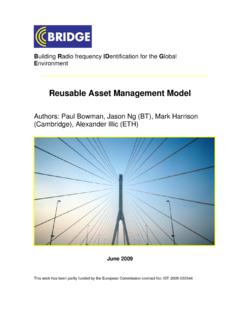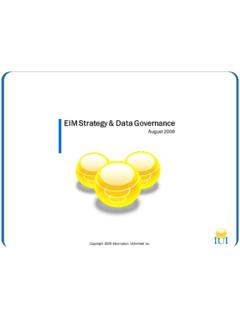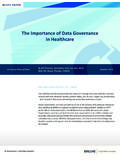Transcription of Private equity: evolution of the operating model - EY
1 Financial ServicesApril 2012 Private equity : evolution of the operating modelBy Samer Ojjeh and Manuel VillavicencioExecutive summaryA barrage of investor, regulatory and economic pressures means that Private equity fi rms can no longer afford to solely rely on deal-making prowess while overlooking investments in the back and middle offi ces. The Private equity (PE) industry is at a critical point of maturity and many fi rms are making signifi cant decisions with regard to their long-term operating infrastructure. Many of these decisions share a common objective: adding value to the business via effective production, management and deployment of information acrossthe more than ever, Private equity fi rms have started to take a serious look at the state of their operating infrastructure.
2 These fi rms have recognized that they can no longer rely on manually-intensive spreadsheets and small-business software to manage billions of dollars of investor assets. Over the past decade, many of the leading hedge fund managers have evolved rapidly in response to calls from institutional investors to develop more sophisticated, consistent and mature operating practices along the lines of traditional Securities and Exchange Commission (SEC)-registered asset managers such as mutual funds. In order to preserve and expand their share of institutional asset allocation over the coming years, Private equity fi rms will be compelled to continue developing and evolving their operating model to keep pace with the rest of the asset management to changeRecently promulgated standards by the Institutional Limited Partners Association (ILPA) are a refl ection of the need by select investors for more transparency, quality and consistency of information from their General Partners (GP)s.
3 Although these standards continue to be refi ned as fi rms and investors attempt to reach a mutual defi nition of best practices, what is certain is that, as evidenced historically by other asset classes, funds will fl ow to the fi rms that combine solid investment returns with sound risk management practices and client service standards. In addition to the ILPA standards, other regulatory measures such as the Foreign Account Tax Compliance Act (FATCA), the Alternative Investment Fund Managers (AIFM) Directive in Europe, and the SEC s Form PF fi ling requirement represent the new, more demanding reporting environment that Private equity fi rms face. 2 Private equity : evolution of the operating model2 Private equity : evolution of the operating modelIn a market increasingly characterized by competition for the best assets, a solid operating infrastructure is a precondition for success.
4 When money was pouring into ever-larger Private equity funds during the pre-2008 boom, managers could afford to defer major operational improvements. However, since the global fi nancial crisis, Private equity fundraising has been challenging. Given investors liquidity concerns and generally more sober view of alternative investments in the post-crisis environment, Private equity fi rms are fi nding that having a robust and well-coordinated operating infrastructure is increasingly a prerequisite for attracting issues take on more importance and diffi culty as fi rms diversify their business models, either organically or through strategic acquisition, away from traditional leveraged buyouts and into other markets, such as credit, bank debt, distressed debt, traditional asset management and advisory, in order to smooth revenue streams and broaden their earnings and returns.
5 This is especially true for fi rms seeking to follow the lead of Private equity companies that are going or have gone public. IPO aspirants will need rock-solid operational infrastructure to satisfy regulators, exchanges and shareholders. Even if accessing the public market is not an immediate goal, it is important to have sound processes and data to address the increased reporting demands of key the fi nancial crisis, competition for deals and credit to fi nance acquisitions has increased alongside competition for investors funds. There is far more weakness in the debt markets, resulting in more equity being put into deals, challenging overall returns. This, along with the changing regulatory environment, has put pressure on fees and given investors the ability to make other demands, such as for more transparency and customized reporting.
6 Key driversWhat is happening in the Private equity industry?What is the impact on Private equity fi rms?Regulatory reform Regulatory reform in the wake of the recent economic downturn impacting Private equity fi rms, including Dodd-Frank, FATCA andself-regulation initiatives such as ILPA reporting guidelines Stricter regulatory environment and disclosure requirements driving fi rmwide process improvement and data management initiativesShifts in business model Firms diversifying their business models away from traditional leveraged buyouts and diversifying into other businesses ,such as credit funds, bank debt, distressed debt, traditional asset management and advisory in order to smooth revenue streams and broaden their earnings and returns Shifts to new, unfamiliar and complex asset classes result in signifi cant challenges in the ability to scale adequately and provide needed expertiseFundraising environment Institutional investor concerns around liquidity, fraud and reduced appetite for risk posing signifi cant challenges to fi rms continued ability to raise funds Increased LP focus on operational due diligence.
7 Including processes and internal controls seen as a key factor in fundraising successInvestor demands New and increasingly stringent reporting requirements for many investment managers with PE holdings resulting in pressures for greater transparency from PE funds Overall greater demand by PE fi rms for technology vendors and fund administration service providers n order to provide timely and accurate data to LPs3 Private equity : evolution of the operating modelFrom ad hoc to best practiceThe days of the back offi ce serving as a factory for capital calls and fi nancial statements are over. The modern objective of the Private equity operating model is to support the business of deal-making and value creation, and ultimately to enable the fi rm to provide timely and relevant information to stakeholders.
8 In order to achieve this level of value creation, operations must be able to provide accurate, timely and useful information but, most critically, in reusable forms to avoid the deployment of costly resources in activities that essentially reinvent the wheel every time information is collected and analysisis maturity model for Private equity technology demonstrates the increasing benefi ts gained as fi rms progress from an entirely manual environment towards a more advanced level of maturity and automation in which they are able to use technology strategically to extract valuable information that can be used to analyze trends, determine root causes and make predictions.
9 (See diagram.) Leading PE fi rms have identifi ed the need to move rapidly up the development pyramid in order to carve out a competitive advantage. The typical path of development in terms of operations and technology is highly consistent among fi rms. In early stages, fi rms often start out with small-business software packages for fund accounting and fi nancial statements. Other common activities, including capital accounts allocations, performance analysis and fi nancial reporting, are performed using Excel these functions become ineffective in supporting increasing volume and complexity, fi rms develop in-house tools or purchase off-the-shelf systems to handle activities such as fund accounting, management company accounting, contact management and investor correspondence.
10 Their decisions are based on immediate, short-term needs. Some of these off-the-shelf systems have gained signifi cant traction in the market and have become mission-critical to many fi rms. However, since few product or data standards have been developed, the opportunities for integrating these platforms to achieve reporting effi ciencies have been limited. Hence, fi rms systems and tools for accounting, CRM, portfolio management, investor reporting and other key functions developed along decidedly separate integrationTactical integrationMulti-system environmentLow data integrationPartial system automationManual environmentBasicDevelopingEstablishedAdv ancedLeadingBasic transaction processing for fund and management company activities.
















